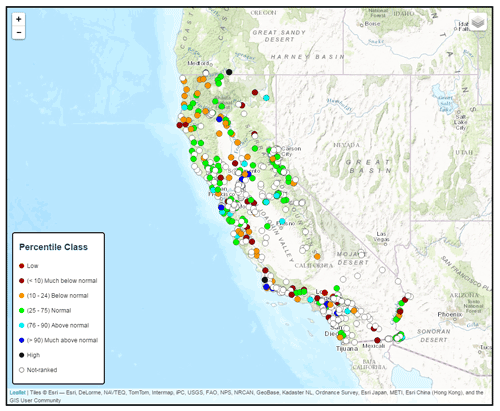CRT: Cascade Routing Tool to Define and Visualize Flow Paths for Grid-Based Watershed Models

Diagram showing cascading flow patterns of overland flow among hydrologic response units (HRUs) and streams delineated from A, topography intersected by elevation bands and from B, a rectangular grid.
The U.S. Geological Survey Cascade Routing Tool (CRT) is a computer application for watershed models that include the coupled Groundwater and Surface-water FLOW model GSFLOW and the Precipitation-Runoff Modeling System (PRMS). CRT generates output to define cascading surface and shallow subsurface flow paths for grid-based model domains. CRT also includes an option to condition the grid-scale DEM to fill unintended swales and to provide continuous down-sloping HRUs that follow streams. CRT requires a land-surface elevation for each hydrologic response unit (HRU) of the model grid; these elevations can be derived from a Digital Elevation Model (DEM) raster data set of the area that contains the model domain. Additionally, a list is required of the HRUs that contain streams, swales, lakes, and other cascade termination features along with indices that uniquely define these features. Cascade flow paths are determined from the altitudes of each HRU. Cascade paths can occur across any of the four faces of an HRU, to a stream, or to a lake within or adjacent to an HRU. Cascades can terminate at a stream, lake, or HRU that has been designated as a watershed outflow location.
Source Code for CRT version 1.3.1 (March 30, 2017)
- A Readme.txt [11KB TXT] file containing installation instructions is included with the Microsoft Windows software distribution file.
- CRT version 1.2.0 compiled for Microsoft Windows [17.5MB ZIP], with source code, documentation, and test problems
- Supplementary GIS data for test problems [54.2MB ZIP]
Documentation
Henson, W.R, Medina, R.L., Mayers, C.J., Niswonger, R.G., and Regan, R.S., 2013, CRT -- Cascade Routing Tool to define and visualize flow paths for grid-based watershed models: U.S. Geological Survey Techniques and Methods 6-D2, 28 p.
Useful Links
How to Cite
This USGS software has two citations associated with it.
- The report citation is for the original report or article documenting the underlying theory, methods, instructions, and (or) applications at the time the initial version of the software was released. This digital object identifier (DOI) is for the report.
- The software release citation is for the software/code itself (now referred to by USGS as a "Software Release") and references a specific version of the code and associated release date. This DOI links to the code.
In instances where an author is citing use of this software, it would be appropriate to cite both the report documenting the code and the specific software release version that was used.
Report Citation for CRT
Henson, W.R, Medina, R.L., Mayers, C.J., Niswonger, R.G., and Regan, R.S., 2013, CRT -- Cascade Routing Tool to define and visualize flow paths for grid-based watershed models: U.S. Geological Survey Techniques and Methods 6-D2, 28 p.
Software/Code Citation for CRT v1.3.1
Henson, W.R. and Niswonger, R.G., 2016, CRT version 1.3.1 -- Cascade Routing Tool to define and visualize flow paths for grid-based watershed models: U.S. Geological Survey Software Release, 30 March 2017, http://dx.doi.org/10.5066/F7HT2MG1
Example USGS Applications of the Cascade Routing Tool
Albano, C.M., Dettinger, M.D., McCarthy, M.I., Welborn, T.L., and Cox, D.A., 2015, Use of a hypothetical winter-storm disaster scenario to identify vulnerabilities, mitigation options, and science needs in the greater Lake Tahoe, Reno, and Carson City region, USA: Natural Hazards, vol 79, 22 p., http://dx.doi.org/10.1007/s11069-015-2003-4.
Allander, K.K., Niswonger, R.N., and Jeton, A.E., 2014, Simulation of the Lower Walker River Basin hydrologic system, west-central Nevada, Using PRMS and MODFLOW models: U.S. Geological Survey Scientific Investigations Report 2014-5190, 93 p., http://dx.doi.org/10.3133/sir20145190.
Carroll, R. W., Huntington, J. L., Snyder, K. A., Niswonger, R., Morton, C., and Stringham, T. K., 2016, Evaluating mountain meadow groundwater response to Pinyon Juniper and temperature in a Great Basin watershed: Ecohydrology, http://dx.doi.org/10.1002/eco.1792
Ely, D.M., and Kahle, S.C., 2012, Simulation of groundwater and surface-water resources and evaluation of water-management alternatives for the Chamokane Creek basin, Stevens County, Washington: U.S. Geological Survey Scientific Investigations Report 2012-5224, 74 p.
Essaid, H.I., and Hill, B.R., 2014, Watershed-scale modeling of streamflow change in incised montane meadows: Water Resources Research, vol. 50, pp. 2657-2678, doi:10.1002/2013WR014420.
Huntington, J.L., and Niswonger, R.G., 2012, Role of surface-water and groundwater interactions on projected summertime streamflow in snow dominated regions: An integrated modeling approach: Water Resources Research, vol. 48, W11524, doi: 10.1029/2012WR012319.
Niswonger, R.G., Allander, K.K., and Jeton, A.E., 2014, Collaborative modelling and integrated decision support system analysis of a developed terminal lake basin: Journal of Hydrology, http://dx.doi.org/10.1016/j.jhydrol.2014.05.043.
Tanvir Hassan, S.M., Lubczynski, M.W., Niswonger, R G., and Su, Z., 2014, Surface-groundwater interactions in hard rocks in Sardon Catchment of Western Spain: an integrated modeling approach: Journal of Hydrology, doi: 10.1016/j.jhydrol.2014.05.026. Available online at http://www.sciencedirect.com/science/article/pii/S0022169414003904
Point of Contact
Support is provided for correcting bugs and clarification of how the code is intended to work. Only limited assistance can be provided for applying CRT to specific problems by contacting the point of contact listed below:
Wesley HensonU.S. Geological Survey
4165 Spruance Rd, Suite 200
San Diego, CA 92103 Richard Niswonger
U.S. Geological Survey
2730 N. Deer Run Road
Carson City, NV 89701
Disclaimers and Notices
Please refer to the USGS Water Resources Software User Rights Notice for complete use, copyright, and distribution information. This software has been approved for release by the U.S. Geological Survey (USGS). Although the software has been subjected to rigorous review, the USGS reserves the right to update the software as needed pursuant to further analysis and review. No warranty, expressed or implied, is made by the USGS or the U.S. Government as to the functionality of the software and related material nor shall the fact of release constitute any such warranty. Furthermore, the software is released on condition that neither the USGS nor the U.S. Government shall be held liable for any damages resulting from its authorized or unauthorized use.


![Go to CRT documentation report [Image: Cover of software documentation report. ]](http://pubs.usgs.gov/tm/tm6d2/images/tm6-D2.jpg)

